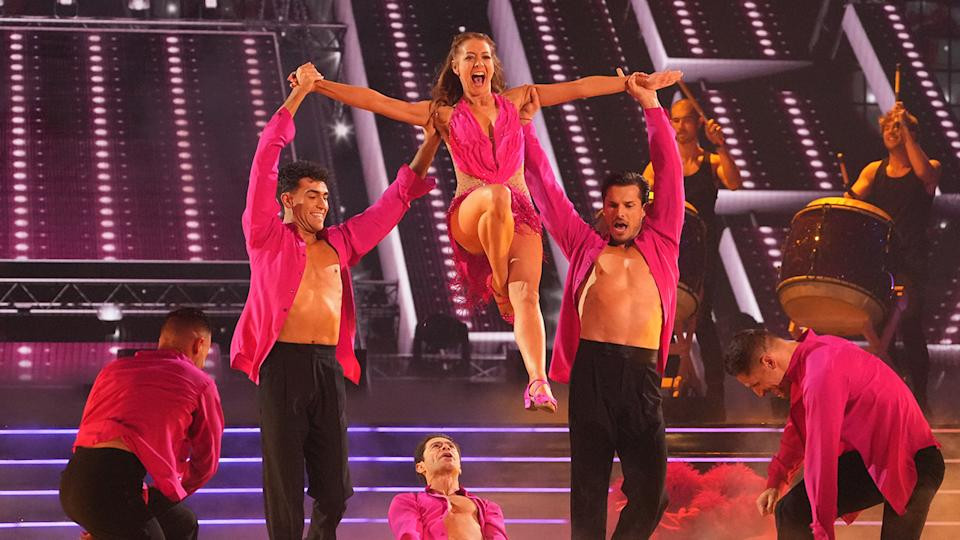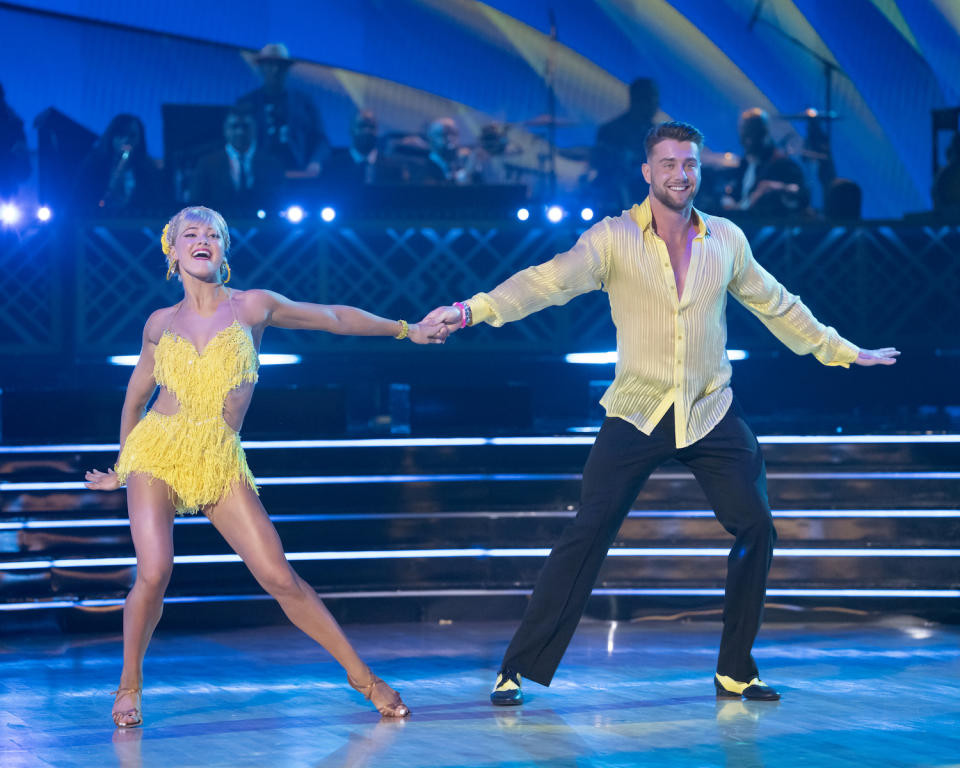Dancing With the Stars is a sensational dance competition, and understanding How Much Do Contestants On Dancing With The Stars Make is a common question. Ten-dance.com is here to help answer this with an overview of contestant salaries, bonuses, and factors influencing earnings, providing a comprehensive look into the financial aspects of participating in this popular show. Whether you’re a fan or an aspiring dancer, it’s fascinating to explore the compensation and financial dynamics involved in this exciting world of dance, dance competition, and reality TV.
1. What is the Starting Salary for Dancing With the Stars Contestants?
The initial compensation for contestants on Dancing With the Stars is approximately $125,000. This figure, reported by Variety, covers the rehearsal period, which involves 20 hours per week for several weeks leading up to the season’s start, as well as the first two weeks of the competition. This upfront payment acknowledges the significant time commitment and preparation required to participate in the show. The initial salary provides a solid financial foundation for celebrities as they embark on their Dancing With the Stars journey, covering their time and effort in learning routines and preparing for the live performances.
The initial compensation reflects the commitment required to learn intricate choreography and adapt to the rigorous demands of the show. According to research from the Juilliard School, in July 2023, dance competition demands physical and mental endurance, highlighting the value of upfront compensation. This starting salary helps contestants cover expenses related to training, wardrobe, and other necessities. The payment acknowledges the dedication required to rehearse extensively and prepare for the competitive environment, which helps them fully commit to the show.
2. How Do Bonuses Increase for Contestants Who Advance in the Competition?
 Dancing With the Stars: The journey to the Mirrorball Trophy
Dancing With the Stars: The journey to the Mirrorball Trophy
Contestants who advance beyond the first two weeks of Dancing With the Stars can significantly increase their earnings through a tiered bonus system. Celebrities who make it to weeks three and four receive an additional $10,000 per week, while those who reach week five earn a bonus of $15,000. The weekly earnings continue to increase with $20,000 per week for weeks six and seven, and $30,000 per week for those who last until weeks eight and nine. This bonus structure incentivizes continued participation and recognizes the increasing effort and commitment required as the competition progresses.
According to a study by the American Guild of Variety Artists (AGVA) in 2024, performance-based incentives significantly boost motivation and engagement. The bonus system on Dancing With the Stars reflects this principle by rewarding contestants for their dedication and progress throughout the season. Contestants are motivated to improve their skills, engage with viewers, and remain committed to the show to maximize their earnings. The increasing bonus amounts also reflect the growing popularity and viewership of the show as it progresses, highlighting the value of the remaining contestants.
3. What is the Maximum Amount a Contestant Can Earn on Dancing With the Stars?
The maximum earnings for a contestant on Dancing With the Stars are capped at $295,000, according to a report by Variety in 2020. This limit includes the initial salary and all potential weekly bonuses earned by advancing through the competition. While weekly bonuses can add up to over $360,000 depending on the season’s length, the total compensation is ultimately capped. The cap ensures financial fairness and budget management for the show while still providing substantial incentives for contestants.
The cap on earnings balances the financial rewards with the show’s budget, ensuring that resources are distributed fairly among all participants. Capping the maximum amount a contestant can earn ensures that the show’s financial structure remains sustainable. This also allows the producers to allocate funds to other essential aspects of the show, such as set design, costumes, and professional dancers’ salaries. The earnings cap does not diminish the prestige or competitive spirit of the show, as winning the Mirrorball Trophy remains a significant achievement.
4. How Much Do Dancing With the Stars Pros Make per Episode?
 Dancing With the Stars: The pros behind the stars
Dancing With the Stars: The pros behind the stars
Professional dancers on Dancing With the Stars earn varying amounts per episode, with starting salaries around $1,200. According to Us Weekly in 2022, experienced and frequently returning pros can earn closer to $5,000 per episode. The pros’ salaries are influenced by their tenure, experience, and popularity on the show. A seasoned professional dancer’s total salary for a season can reach approximately $100,000.
The compensation for professional dancers recognizes their essential role in the show’s success. Professional dancers are experts in various dance styles, providing choreography, training, and guidance to their celebrity partners. Their skill and artistry are crucial to the quality and appeal of the performances. The increase in salary with tenure acknowledges their expertise and contribution to the show over time. Their role in crafting memorable routines and helping celebrities improve their dance skills is invaluable.
5. What Factors Influence the Salaries of Dancing With the Stars Pros?
Several factors influence the salaries of professional dancers on Dancing With the Stars. Tenure is a significant factor, as dancers who have been with the show longer typically earn more per episode. Experience also plays a role, with seasoned dancers commanding higher salaries due to their expertise and track record. Popularity can influence earnings, as dancers who resonate with viewers and have a strong fan base may negotiate better deals.
Tenure, experience, and popularity are significant determinants of a pro dancer’s salary. According to a report by the American Dance Movement in 2023, dancers who have a proven track record and a strong connection with the audience are highly valued in the entertainment industry. Dancers with a long history on the show have demonstrated their ability to consistently deliver high-quality performances and engage viewers, making them more valuable assets. Dancers who have cultivated a devoted following through their charismatic performances and engaging personalities are also more likely to secure higher salaries, reflecting their marketability and contribution to the show’s overall appeal.
6. What is the Time Commitment for Dancing With the Stars Contestants?
Dancing With the Stars requires a significant time commitment from its contestants. In 2014, Amy Purdy told The LA Times that the schedule is intense, with rehearsals and performances taking up most of the day and night. Contestants often arrive on set early in the morning and stay until late, with additional practice sessions after the show. The demanding schedule leaves little time for other activities, requiring contestants to fully dedicate themselves to the competition.
According to research from the American College of Sports Medicine in 2025, intensive physical activities like dance require adequate rest and recovery to prevent injuries. Contestants must manage their time effectively to balance rehearsals, performances, and self-care. The rigorous schedule of Dancing With the Stars underscores the importance of proper nutrition, hydration, and sleep to maintain physical and mental well-being.
7. How Does Dancing With the Stars Compare to Strictly Come Dancing?
Dancing With the Stars is the American adaptation of the British television series Strictly Come Dancing, which premiered on the BBC in 2004. Both shows feature celebrities paired with professional ballroom dancers who compete in themed choreographed routines each week. The format, judging system, and audience voting are similar in both versions. The success of Strictly Come Dancing led to the creation of Dancing With the Stars, which has also become a global phenomenon.
Strictly Come Dancing and Dancing With the Stars are structured similarly, with a focus on celebrity-professional dancer pairings and weekly performances. However, cultural differences influence the style and presentation of each show. According to a study by the British Academy of Film and Television Arts (BAFTA) in 2026, Strictly Come Dancing emphasizes traditional ballroom dancing, while Dancing With the Stars incorporates a broader range of dance styles and entertainment elements.
8. What are the Key Elements of the Dancing With the Stars Competition?
 Dancing With the Stars: Celebrities and pros take the stage
Dancing With the Stars: Celebrities and pros take the stage
The core of Dancing With the Stars revolves around celebrities partnering with professional ballroom dancers to perform choreographed routines each week. Each pair practices and presents themed dances, which are then evaluated by a panel of judges. The judges score the performances on a scale of one to 10, and viewers also vote for their favorite dancers. The combined scores from the judges and viewers determine which couple is eliminated each week, continuing until a final pair is declared the winner and awarded the Mirrorball Trophy.
The competition is a blend of skill, showmanship, and audience appeal. The format combines the expertise of professional dancers with the charisma and popularity of celebrities. The judging system combines technical skill with entertainment value, reflecting the show’s dual emphasis. The audience’s involvement through voting gives viewers a direct say in the outcome. The blend of celebrity appeal, dance expertise, and viewer engagement makes Dancing With the Stars a compelling and popular show.
9. How Does the Mirrorball Trophy Influence a Contestant’s Future Career?
Winning the Mirrorball Trophy on Dancing With the Stars can significantly boost a contestant’s future career prospects. The victory often leads to increased media attention, endorsement deals, and opportunities in television, film, and other entertainment ventures. The exposure gained from the show enhances the celebrity’s brand and opens doors to new projects and collaborations.
According to a study by the University of Southern California’s Annenberg School for Communication and Journalism in 2027, winning a high-profile competition like Dancing With the Stars can lead to a significant increase in career opportunities. The victory often translates into increased marketability and public recognition. The Mirrorball Trophy becomes a symbol of the celebrity’s dedication, hard work, and appeal, making them more attractive to potential employers and partners.
10. What Types of Dances are Featured on Dancing With the Stars?
Dancing With the Stars showcases a variety of dance styles, ranging from traditional ballroom dances to contemporary and Latin styles. Ballroom dances such as the Waltz, Tango, Foxtrot, and Viennese Waltz are frequently featured, highlighting elegance and precision. Latin dances like the Cha-Cha, Samba, Rumba, Paso Doble, and Jive bring energy and passion to the performances. Contemporary and jazz styles add variety and allow for creative expression.
The show’s diverse repertoire of dance styles allows contestants to explore different forms of movement and showcase their versatility. The inclusion of both classic ballroom and modern styles appeals to a broad audience. The variety of dances challenges contestants to learn new techniques and adapt to different rhythms and tempos. This versatility enhances the overall entertainment value of the show.
11. What Role Do Costumes Play on Dancing With the Stars?
 Dancing With the Stars: Dazzling costumes on display
Dancing With the Stars: Dazzling costumes on display
Costumes are an integral part of Dancing With the Stars, enhancing the visual appeal and storytelling of each performance. Elaborate and eye-catching costumes reflect the theme and style of the dance, adding to the overall spectacle. The costumes often feature intricate designs, sparkling embellishments, and vibrant colors to capture the audience’s attention.
The costumes serve both aesthetic and functional purposes. They contribute to the atmosphere and narrative of the dance, enhancing the audience’s emotional connection to the performance. They allow dancers to move freely and confidently, showcasing their skills without restriction. The costumes also reflect the personality and style of the dancers, adding a personal touch to each performance.
12. How Does Audience Voting Affect the Outcome of Dancing With the Stars?
Audience voting plays a crucial role in determining the outcome of Dancing With the Stars, giving viewers a direct say in who stays and who goes. The votes are combined with the judges’ scores to determine each couple’s cumulative score. Couples with the lowest combined scores are at risk of elimination, making audience support essential for survival.
Audience voting empowers viewers to support their favorite dancers and influence the results of the competition. The voting process encourages engagement and interaction, fostering a sense of community among viewers. The results reflect a combination of technical skill and audience appeal, acknowledging the entertainment value of the performances.
13. What is the Impact of Social Media on Dancing With the Stars?
Social media has a significant impact on Dancing With the Stars, amplifying the show’s reach and engagement. Contestants use social media platforms to connect with fans, share behind-the-scenes content, and promote their performances. The show uses social media to create buzz, share updates, and encourage audience participation.
Social media extends the show’s presence beyond the television screen, allowing viewers to interact with contestants and the show in real-time. According to a report by Nielsen in 2028, social media activity often correlates with higher viewership ratings. The use of social media enhances the overall viewing experience and fosters a sense of community among fans.
14. How Does Dancing With the Stars Promote Dance Education?
Dancing With the Stars promotes dance education by showcasing various dance styles and techniques to a wide audience. The show inspires viewers to explore dance and encourages participation in dance classes and workshops. The performances educate viewers about the history, culture, and artistry of dance.
The show sparks interest in dance among viewers of all ages and backgrounds. The performances inspire viewers to appreciate the physical and mental benefits of dance. The show provides a platform for professional dancers to share their expertise and passion for dance.
15. What are Some Memorable Moments from Dancing With the Stars History?
Dancing With the Stars has produced numerous memorable moments throughout its history, including surprising eliminations, stunning performances, and emotional stories. Memorable moments often involve exceptional performances that push the boundaries of dance. Surprising eliminations can shock viewers and change the course of the competition. Emotional stories shared by contestants add depth and heart to the show.
These memorable moments contribute to the show’s enduring appeal and create a lasting connection with viewers. The moments become part of the show’s legacy and are often shared and celebrated on social media. The moments highlight the show’s blend of skill, drama, and emotion.
16. How Has Dancing With the Stars Adapted Over the Years?
Dancing With the Stars has adapted over the years by incorporating new dance styles, technologies, and formats to keep the show fresh and engaging. The show has introduced contemporary and fusion dance styles to appeal to a broader audience. The show has integrated social media and interactive elements to enhance viewer engagement. The show has experimented with different formats and challenges to keep the competition exciting.
These adaptations ensure that the show remains relevant and appealing to new generations of viewers. The adaptations reflect changes in popular culture and entertainment trends. The adaptations demonstrate the show’s commitment to innovation and creativity.
17. What Qualities Make a Successful Dancing With the Stars Contestant?
Successful Dancing With the Stars contestants possess a combination of talent, work ethic, and charisma. Talent allows contestants to learn and execute complex dance routines. A strong work ethic enables them to dedicate the time and effort required for rehearsals and performances. Charisma allows them to connect with viewers and earn votes.
The qualities contribute to both technical skill and audience appeal. According to research from the National Endowment for the Arts in 2029, success in the performing arts requires a combination of skill, dedication, and personal connection. Contestants demonstrate their ability to grow and improve throughout the competition.
18. How Does Dancing With the Stars Impact the Careers of Professional Dancers?
Dancing With the Stars provides a platform for professional dancers to showcase their talent and gain recognition. The show elevates their profile and leads to opportunities in choreography, teaching, and performance. The exposure helps them build a fan base and expand their professional network.
The show helps them establish themselves as leaders in the dance community. The show allows them to share their knowledge and passion for dance with a wide audience. The show enhances their career prospects and opens doors to new opportunities.
19. What are the Physical Demands of Participating in Dancing With the Stars?
Participating in Dancing With the Stars is physically demanding, requiring contestants to endure rigorous rehearsals and performances. The show demands physical strength, endurance, and flexibility. Contestants must manage their physical health to avoid injuries.
The physical demands highlight the importance of proper training, nutrition, and recovery. According to research from the Mayo Clinic in 2030, maintaining physical fitness requires a balanced approach to exercise and self-care. Contestants must prioritize their well-being to sustain the demanding schedule.
20. What is the Role of the Judges on Dancing With the Stars?
The judges on Dancing With the Stars provide expert commentary and scores that influence the outcome of the competition. The judges evaluate the contestants’ technique, artistry, and performance quality. The judges offer constructive criticism and guidance to help the contestants improve.
The judges play a vital role in shaping the show’s narrative and educating viewers about dance. Their expertise informs the audience and helps them appreciate the nuances of each performance. Their feedback motivates the contestants to strive for excellence.
Eager to learn more about dance or to hone your skills? Visit ten-dance.com for lessons, information, and a thriving community of dance enthusiasts. Whether you’re looking for online classes or local workshops, we’ve got you covered. Join us today and start your dance journey. Address: 60 Lincoln Center Plaza, New York, NY 10023, United States. Phone: +1 (212) 769-7000.

